Home to dozens of Roman ruins, the city of Mérida sits proudly on the Iberian Peninsula just 174 miles (280 km) southwest of Madrid. This ancient city is located in the Badajoz province in the Extremadura region of western Spain, an area known for its dry summers and rainy winters.

Founded in 25 B.C., Mérida has rightly earned its title as a World Heritage Site. It boasts an ensemble of Roman sites. The city’s name evolved from its original one of Emerita Augusta, which means Army of Augustus. Mérida, also referred to as “mini Rome,” was designated by the Emperor for Roman legionnaires and their families. Mérida eventually evolved into the capital of Lusitania, which was arguably the most important province in the western empire and included the area of modern-day Portugal. Today Mérida is home to more ancient Roman monuments than any other Spanish city.
Over time, the Extremadura region was held under Christian, Moorish and Portuguese control. These different societies not only influenced the culture, but also the various types of architecture found throughout Mérida. Because of its close proximity to the Portuguese border, Mérida shares much of its history with its neighbor to the west. It is a popular stopover for those traveling from Madrid to Lisbon. As a small city, Mérida offers the convenience of short walking distances. In 3 to 4 days visitors can easily explore Mérida’s attractions as well as the day trip towns of Zafra and Jerez de los Caballeros. Here are the must sees and dos in Merida, Spain!
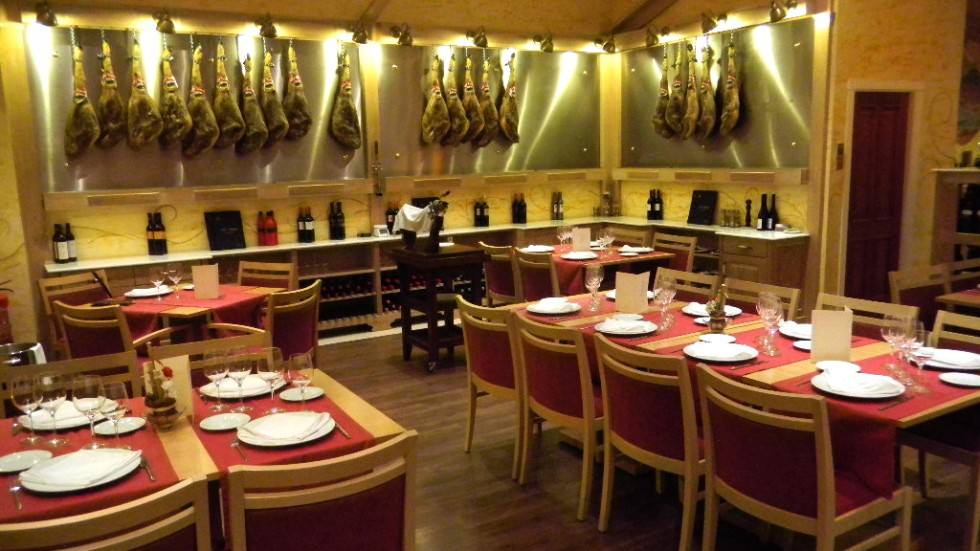
Rex Numitor (Calle Castelar, 1) is hands-down the best boutique restaurant in the city of Mérida. Specializing in preparing typical Extremaduran dishes, Rex Numitor also offers a wide selection of wines for sale. Bottles of all kinds are displayed throughout the restaurant, which add Spanish charm to each dining experience. Juicy legs of Jamón ibérico (Iberian ham) hanging in the far end of the restaurant also contribute to Rex’s warm, Spanish charm.
The owner of Rex Numitor is also a ham producer, so you can be sure that what you are getting is of the freshest quality. You can find his shop, El Yantar, in front of the Roman theater only one block away from the Roman Bridge and Plaza de España (Calle Don José Álvarez Y Sáenz de Buroaga, 12/ Phone: +34 924 316 354/ www.jamoneselyantar.com).

El Yantar is a great place to try different kinds of cheeses and Iberian hams. You can even order a leg of ham to be shipped to your home anywhere in the world (with the exception of the U.S.A. because of customs regulations.) It is El Yantar’s careful attention to details like the amount of salt, cooking temperatures, and quality control that makes it such a worthwhile place to dine and buy goodies.
Stop into Pizzeria Galileo (Calle John Lennon, 28) for a casual meal and a slice of history. This pizza shop is located in front of the Alcazaba and makes for the perfect lunch spot while touring Mérida’s ancient sites. Their menu offers over 30 types of freshly baked pizzas, calzones, and pasta dishes. After fueling up on delicious Italian specialties, head below for the real topper. The basement level of the restaurant features acrylic floor panels, allowing views of excavated Roman ruins below ground. Pizzeria Galileo is open Tuesday through Sunday from 1:30 pm to 4 pm and from 8:30 pm to 12:30 am. Prices range from 4 to 12 Euros.
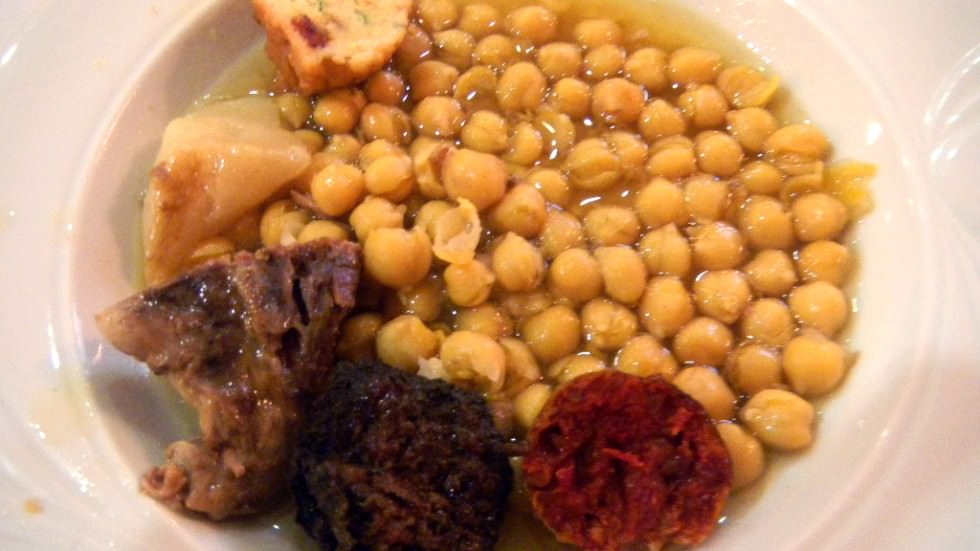
Open since 1949, Briz (Calle Felix Valverde Lilo, 7) is a tavern-style restaurant that has earned a reputation as once of the best restaurants in the region serving hearty Extremaduran specialties. Briz’s menu offers delicacies such as bull testes and cow intestines in addition to other, perhaps more appetizing, food ensembles. While there are plenty of filling choices, patrons also stop in to enjoy pinchos and cañas- Spanish-style appetizers on sticks with beer. Briz’s prices are just one reason it has enjoyed over sixty years of success. Main courses will run you about 12 Euros, but the quality of the meat is superior. Adventurous and picky eaters alike flock here to sample the delicious, noteworthy specialties of Extremadura. Don’t come expecting gorgeous décor and show-stopping food presentation. Briz is a simple, no-frills family-owned establishment. It is open Monday through Saturday.
Calle Felix Valverde Lillo, 7

Like Restaurant Briz, La Corrada (Calle San Juan de Dios, 5) serves up traditional Extremadura cuisine. It is located only two blocks away from Plaza de España, making it a convenient destination to walk to. La Corrada offers a casual bar area located at the front of the building and a main dining hall for larger parties in the back. An interesting feature of the front seating area is the set of wooden barrels used as small tables for guests.
I sat at the barrels and ordered a cheese and chorizo appetizer, followed by a great Extremeño soup served with morcilla (blood sausage), potatoes and meat. Ordering various tapas is a great way to sample several regional favorites and still save room for dessert.
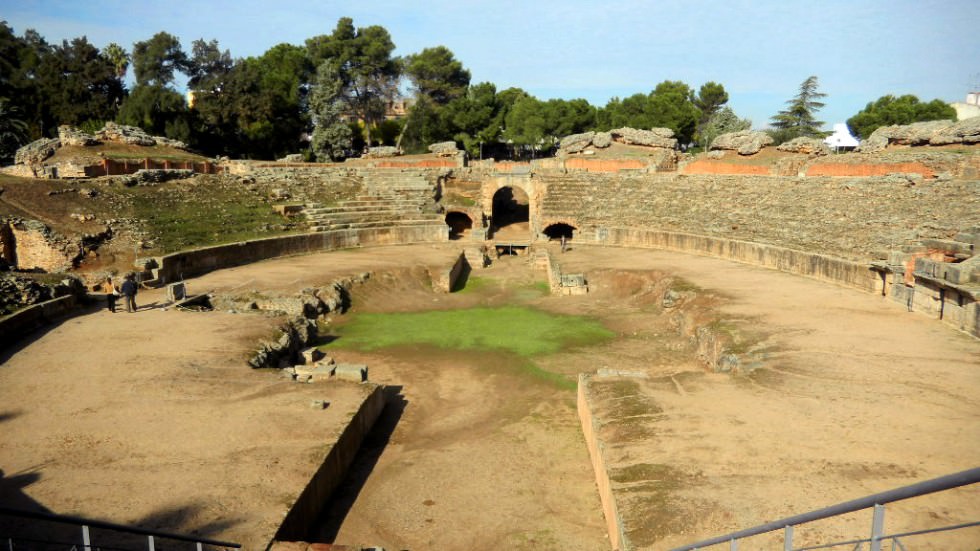
Dating back to 8 B.C., the Mérida amphitheater (Calle de José Ramón Mélida) is one of the oldest archaeological sites in Spain. It was constructed in an oval shape and designed to seat around 15,000 spectators. In true Roman form, classes were unmixed and the commoners’ seats were separated from those of noblemen. The amphitheatre was used for bloody gladiatorial battles between condemned men and wild animals brought from Asia and Africa.
Overall, the amphitheater is rundown with the only intact portions being the center, the interior rows of the grandstand, and the gladiators’ quarters. By the 400’s its walls were taken down and harvested to build other structures. Renovations have allowed for exploration of the corridors in which animals and battlers were held before fights.
The amphitheater is open daily and admission is 8 Euros, which will also grant you entrance to the Roman theater next door. I suggest purchasing a single pass from the ticket office that covers admission to various historical sites around Mérida. This Entrada Conjunta costs 12 Euros and is a great value.

The Roman Theater is located next door to the amphitheater and is in a much better state than its neighbor thanks to several renovation projects. Marcus Agrippa, Roman general and son-in-law of Caesar Augustus, built the theater in 15 B.C. The theater was designed to hold 6,000 spectators. The seats are divided into tiers: first and closest tier (ima cavea), second tier (media), and third tier (summa). The first 22 rows in the ima cavea section were reserved for the wealthiest of Romans.
Plays of all kinds were performed here to delight the crowds of ancient Lusitania. The backdrop to the stage, scaenae frons, has been well preserved. It features Corinthian columns, several inscriptions and marble statues. The theater is old, but it’s far from obsolete. Every summer during July and August the theater’s acoustics still echo throughout the city during Theater Festival. Events include Greek dramas, tragedies, comedies, musicals, and dance shows. Visit www.festivaldeMérida.es for up-to-date scheduling information.

Not much to see at the Circus Maximus (Avenida del Rey Don Juan Carlos I) an ancient Roman hippodrome used for horse and chariot races. Built to resemble the one in Rome, Mérida’s Circus Maximus could sit over 25,000 spectators along the 1,312-foot (400 meter) course. The Circus Maximus is well preserved and still retains a few of its original structures like the triumphal gate and the judges’ panel. It continues to be a popular attraction in town. The Circus Maximus is open daily. Admission is 4 Euros.
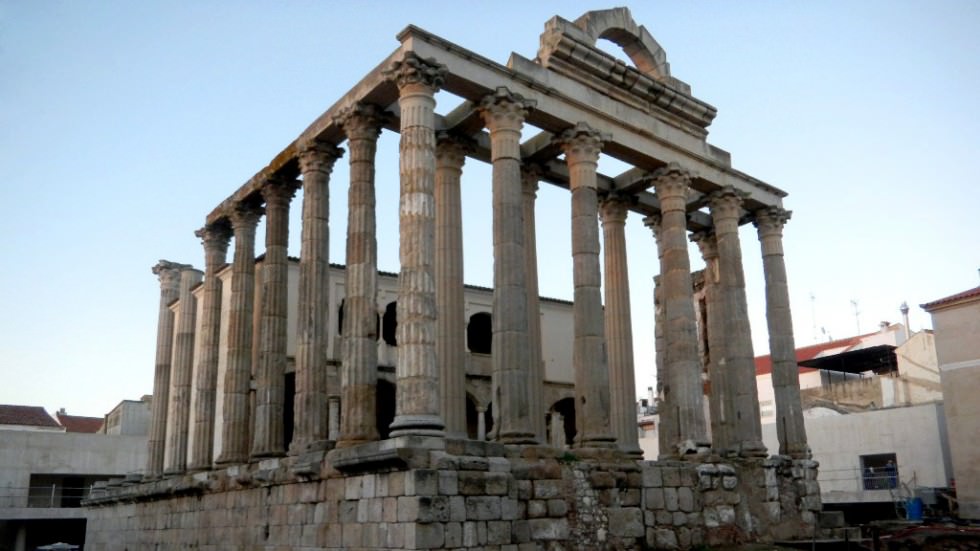
The Temple of Diana (Calle de Santa Catalina) is the only religious building from Emerita Augusta still standing in its original location. Six Corinthian-style granite columns elegantly support what remains of the hexastyle portico. The temple, which was built sometime during the 1st century A.D., was most likely used to worship Emperor Augustus and not Diana like the name suggests. Sculptures of the divine emperor’s family still exist throughout the site.
If something about the temple’s interior structure looks off to you, that’s because it is. During the 16th century Count Corbes decided to build his palace in the center of the temple by re-purposing most of the original stones. Unfortunately this is why an elevated modern structure is situated inside the temple.

Aqueducto Los Milagros, or Aqueduct of the Miracles, is an extraordinary example of Roman masterwork. This 6-mile (10 km) structure was built to supply Emerita Augusta with water collected from the Proserpina cistern located just 3 miles (5 km) from the city. The water traveled along the aqueduct and collected in a large square tank called castellum aquae. With a complex scheme of arches designed to account for natural ground elevations, the aqueduct still stands as a testament to ancient hydraulic engineering. Nowadays the arches are home to dozens of nesting storks. For incredible pictures of the site, visit an hour before dusk.
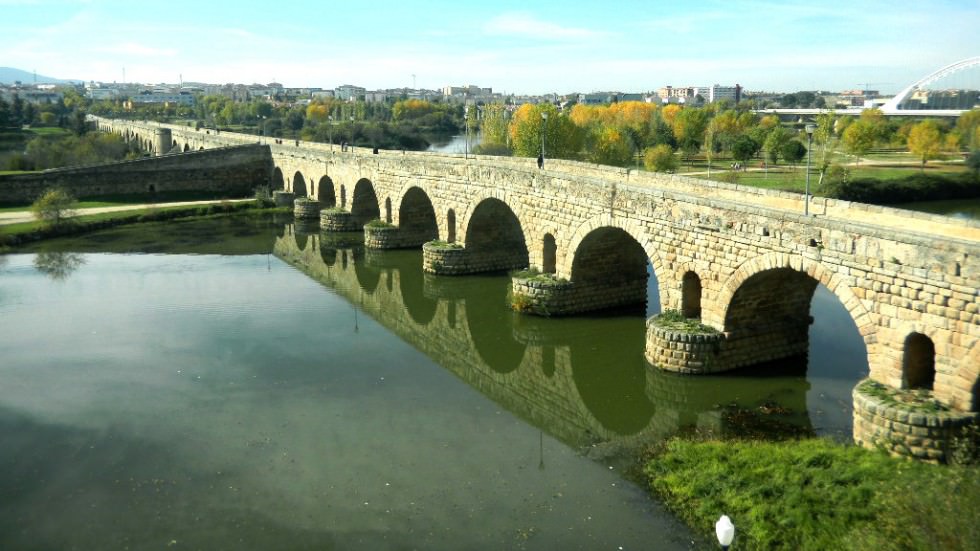
The Roman Bridge of Mérida fortunately has remained in superb condition thanks to the Romans’ consistent efforts in maintaining it. At 2,591 feet (70 m), it is the longest surviving Roman bridge in the world.
It dates back to 25 B.C. and spans across the Guadiana River. The heavy rectangular stones and thick pillars were designed to withstand winter flooding and strong currents. The bridge features 60 (originally it had 62) towering granite arches and has been used as a footbridge since 1993. The Roman bridge is a 2-minute walk from Plaza de España.
Check out: Top Five Roman Ruins in Extremadura, Spain

The Alcazaba (Plaza Del Rastro, Calle Graciano s/n) is an Arab castle completely in ruins located on the north end of the Roman bridge. It offers nice views of the bridge from the top. Built by the Moors in the year 835, the castle is considered a UNESCO World Heritage Site. It was constructed as a fortification over the Guadiana River and can be accessed through a small opening in the Roman Bridge. The Alcazaba was originally purposed to regulate traffic and goods brought in and out of Mérida. It is open daily and admission is 4 Euros.
If you’re a lover of everything Roman, you will surely appreciate the National Museum of Roman Art (Calle José Ramón Mélida, s/n). What makes this museum unique is that an original ancient Roman street runs through it. The street was uncovered during the museum’s construction and has thankfully been spared. Along the path of the first floor you can catch a glimpse of Roman tombs as well as displays of the Romans’ religious life. The second floor consists of exhibits of their daily objects such as ceramic vessels and stone tools. The third floor of the museum features displays of several facets of life from the ancient capital. Many sculptures from the theater and amphitheater are kept here. Tapestries adorn the walls with a series of portraits. The museum contains over 35,000 artifacts from Emerita Augusta!
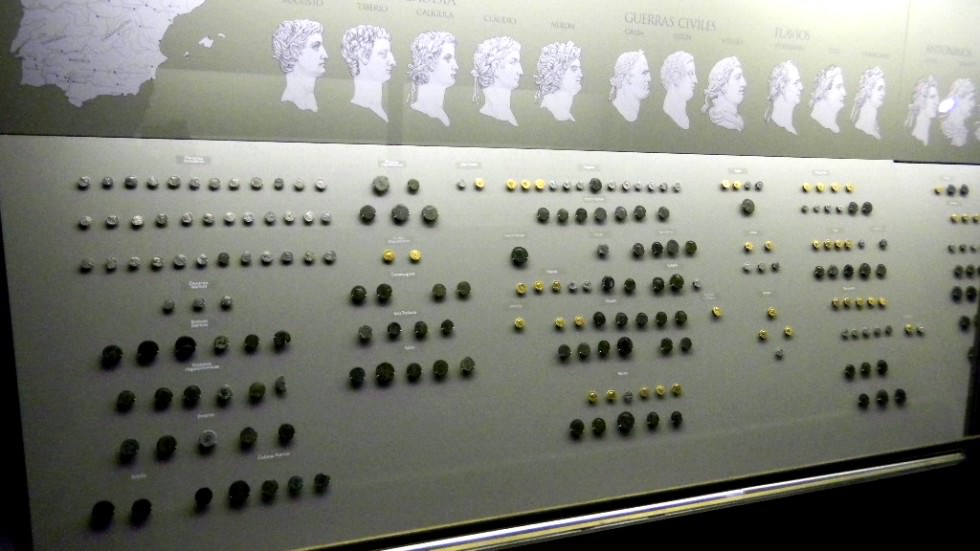
The museum is located about an 8-minute walk east of the Plaza de España and is closed on Mondays. Admission is 3 Euros, but is free on Saturday afternoons, Sunday mornings, and for those 18 and under. Visit www.mnar.es for more information on exhibits, schedules, and special events.
The Visigothic Basilica of Santa Eulalia (Avenida Extremadura, s/n) was built in the 6th century and named after Saint Eulalia, patron saint of Mérida. According to Christian writings, Saint Eulalia was a young Christian virgin girl who publicly opposed the belief in Roman gods. She was tortured and burned at the stake, and was declared a saint because of her martyrdom. Barcelona in Catalonia and Oviedo in Asturias also regard Saint Eulalia as their patron saint. Her feast day is celebrated every year on December 10th.
Outside of the church is a shrine dedicated to Mars, the Roman god of war. Excavations underneath the basilica have uncovered fragments of ancient Roman homes. The basilica is open daily from 9 am to 8:30 pm. Admission is 4 Euros.

The Cornalvo Dam is a Roman gravity dam that was built during the 1st and used to supply the aqueducts of Emerita Augusta with water. Now a tourist attraction in the lush Cornalvo Nature Reserve, the dam stretches for over 636 feet (194 m). The Cornalvo Nature Reserve is located 10 miles northeast of Mérida and boasts a variety of things to do including bird watching, hiking and photography along the banks of the Albarregas River. The reserve also features the man-made Cornalvo Lake that served as a giant reservoir for the citizens of Emerita Augusta.
Emperor Trajan ruled the Roman Empire from 98 A.D. to 117 A.D. He was born in Hispania nearby what is now Sevilla, Spain. He was known to be a just ruler and a dedicated builder in cities throughout his empire. His Greek architect and engineer, Apollodorus of Damascus, is credited with masterminding urban masterpieces such as the Alcántara Bridge in Spain and Trajan’s Bridge in Serbia. Trajan’s Arch in Mérida, although small in comparison to Mérida’s other Roman structures, once stretched over the city’s most important street- the Cardo Maximus, or main street. This simplistic arch represents Emperor Trajan’s reign. It is located near the historical center of Mérida and is about 48 feet (15 meters) tall.
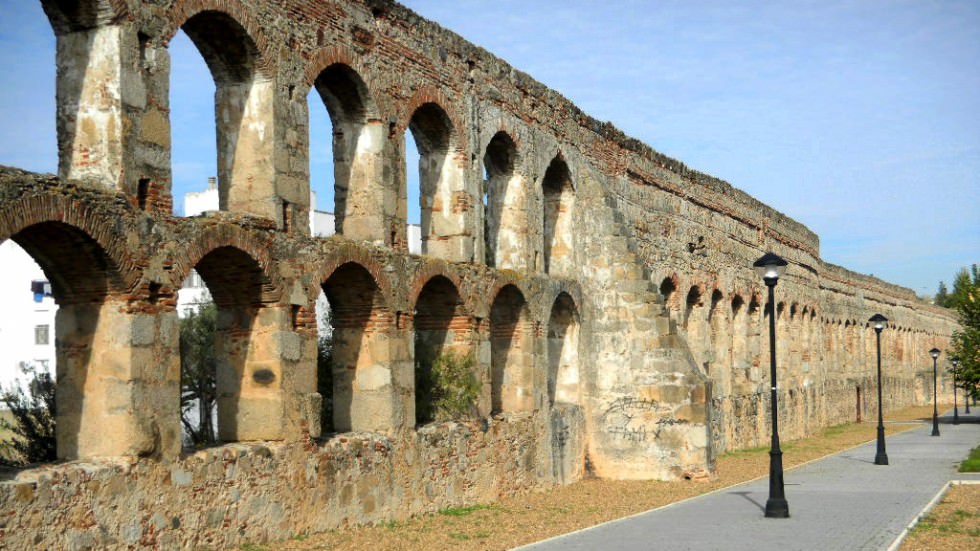
This well-preserved Aqueduct of Saint Lazarus is located next to the Roman Circus and named after the Christian Saint Lazarus who rose from the dead at the command of Jesus Christ. This aqueduct is one of the original three that supplied water to Emerita Augusta. What remains are three pillars and two arches connected by ashars (rectangular blocks) of thick granite. Unfortunately so little of the original structure remains, but what is left still impresses.
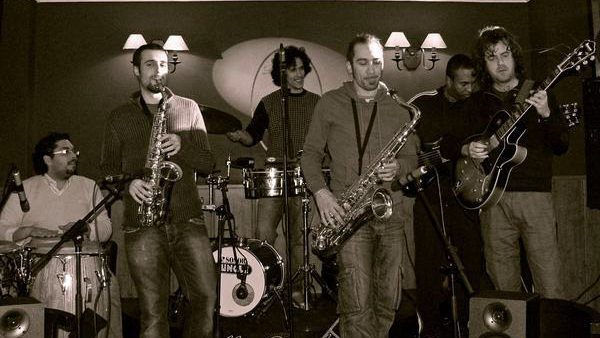
Spain is known to be a country full of sociable people. Mérida locals enjoy talking, drinking and hanging out in the fresh outdoors, especially after the sun goes down. Nightlife in Mérida translates into heading to a casual haunt in or around Plaza de España, then switching gears and heading to another spot. Mérida nightlife can be summarized in 3 C’s: coffee, cañas (beer), and copas. There are a variety of pubs, bars, and nightclubs to choose from, all of which are walking distance from the historical center. Rarely do people have a set plan for the night, often opting to “go with the flow” on foot.
Bars in Mérida offer a relaxing atmosphere where you can decompress after a long day of sightseeing. A few years ago you were likely to only rub elbows with locals in Mérida’s bars, but as word of the city’s Roman treasures has spread internationally, there has been a significant increase in people visiting each year. No matter where the night breeze may carry you, warm hospitality awaits.
Zafra and Jerez de los Caballeros

If you appreciate Roman history and culture as much as I do, then you will really enjoy visiting this town in the heart of the Extremadura region. There is an advantage to its small size; you can see a great deal of historical sites concentrated in and around one place. Out of all of the Roman ruins that I visited while in Mérida, my favorite was the Roman Theater.
I didn’t expect it to be that massive or well preserved. The National Museum of Roman Art was also an unexpected delight for me because I always have preferred roaming outside than strolling indoors. This National Museum of Roman Art contained impressive displays of coins, maps, and pillars- all of which are intact. The exhibits provide further testament to the splendor of the Roman Empire. One eatery you must visit is El Yantar. Try their typical regional cheeses and hams. This place will give you the opportunity to experience what the local produce tastes like and how hospitable the people are in small Spanish towns like this one. I have seen many Roman ruins throughout Europe, but Mérida blew my mind just because of the sheer quantity of them.
Everyone should give time to this small city despite its infrequent mention in popular guidebooks. Make your own plan- it’s all right if you get lost somewhere along the way because you might just discover something incredible.
Helpful websites:
Have anything to add or ask about Mérida? We welcome your feedback! Please leave a comment below.
To the best of our knowledge, all of the information provided in this post was accurate at the time of publishing. Davidsbeenhere.com, LLC. assumes no responsibility for changes or errors.
Counter
101 Countries • 1432 Cities
Edna says:
David
We want to get from Toledo to Merida and then on to Evora in Portugal.
Having trouble trying to figure out the best way to travel as the bus takes hours from Toledo to Merida and from Merida onwards there appears to be no train or bus.
Any suggestions here or should we get a car hire?
Regards
Edna
Mariama says:
hello! Thank you for very helpful information. Am wondering, if you know any good bed & breakfast place for 6 nights in Merida. Am traveling 16. July -21.juli 2017. Thanks,Mariama
David says:
Hi Mariama,
I am so sorry that I didn’t see your comment sooner! Hope you had a great time in Merida!! I hope it worked out 🙂
MARIANNE FERNANDEZ says:
Thank you for this article!
I have been in Sevilla few years ago and it was an amazing experience! I visited a lot of places and did a website about it with some articles 🙂
David says:
thanks for stopping by!
Suzanne Garland says:
We are looking for a place to stay for 2 weeks in March. There are 2 couples. Is 2 weeks to long for Merida? Can you recommend anywhere else in Spain that would have moderate weather? Thanks, Suzanne
Chelsea says:
Thanks so much for writing this! I am handwriting notes down as I spontanteously decided to grab a bus there tomorrow from Lisbon, and leave the following day continuing on to Seville…Really looking forward to this stopover! All of your information is very helpful!
David says:
Thanks Chelsea, have a great time!
Caroline Lenaghan says:
Hi Thank you for such a great site. I am visitng Merida for a day in June and haven’t been able to find if there are guided walking tours available. I just wondered if you came across any individuals so these? I would far prefer to pay an individual than a company as I have found these tours to be very good in other cities. Caroline
David says:
Hi Caroline,
Try going on Tours by Locals dot com. I am sure you can find a guide there. Thank you for writing us!
Letty says:
is there a luggage storage facility available in merida spain? thanks
David says:
Hi Letty, Thanks for stopping by. I honestly have no idea. You may want to go to visit the Merida Tourism website http://www.turismomerida.org/en or contact them directly by phone to ask. Good luck and safe travels to Spain!
Gill says:
Thanks for this helpful information. We are heading there today for a 3 night stay as part of a self planned tour and appreciate the advice!
David says:
Your welcome, Gill. Enjoy 🙂
CHantal says:
Hello
Thanks for the precious info and nice photos. We’ll be travelling Spain by car for 2 weeks (So far, 5 days in Barcelona then follow the coast down and finish with Merida, Cordoba and Seville. How long should we spend in those cities respectively, is it better 1 or 2 days in Merida? We were thinking about arriving on the Tuesday evening, the visit the ruins in the morning, the museum in the afternoon and either sleep there or drive to Cordoba to spend the Tuesday and sleep in Seville for 3 nights. IS that too squeezed? Thanks a lot in advance for your tips.
David says:
Thanks for writing me! I think it is a little rushed. To drive from Barcelona to Merida will take you 12+ hours. From Merida to Sevilla is 3-4 hours and Sevilla to Cordoba is 2 hours. I would say add a day to each Cordoba and Merida because your drive time will take over most of your days and you won’t be able to really enjoy it. Let me know what you think.
Ross says:
Do you know of any tour companies that offer one-day or two-day trips to Merida from Seville or Madrid?
David says:
I don’t unfortunately since every time I travel to Spain I rent a car and drive myself. I wish you luck!